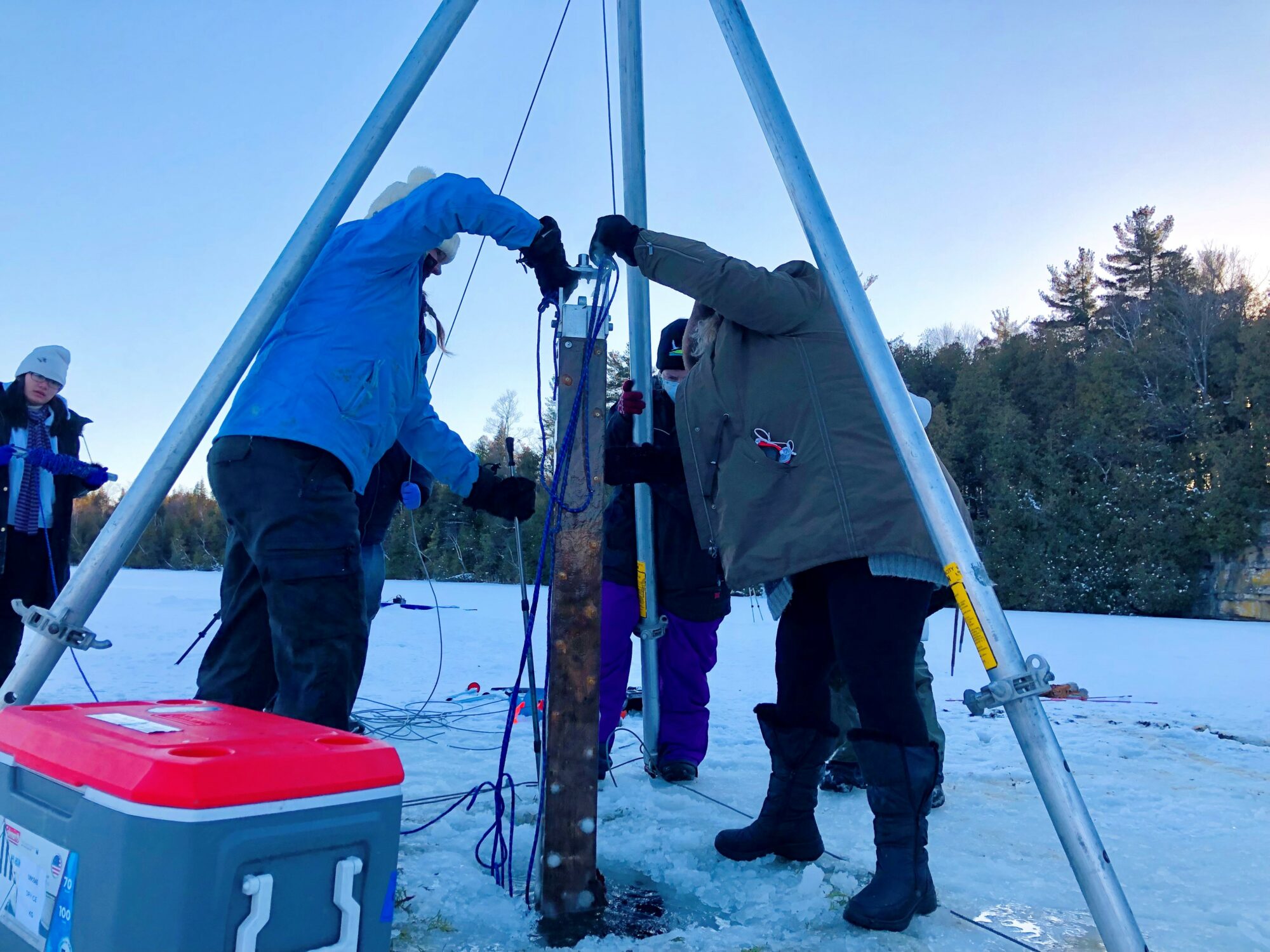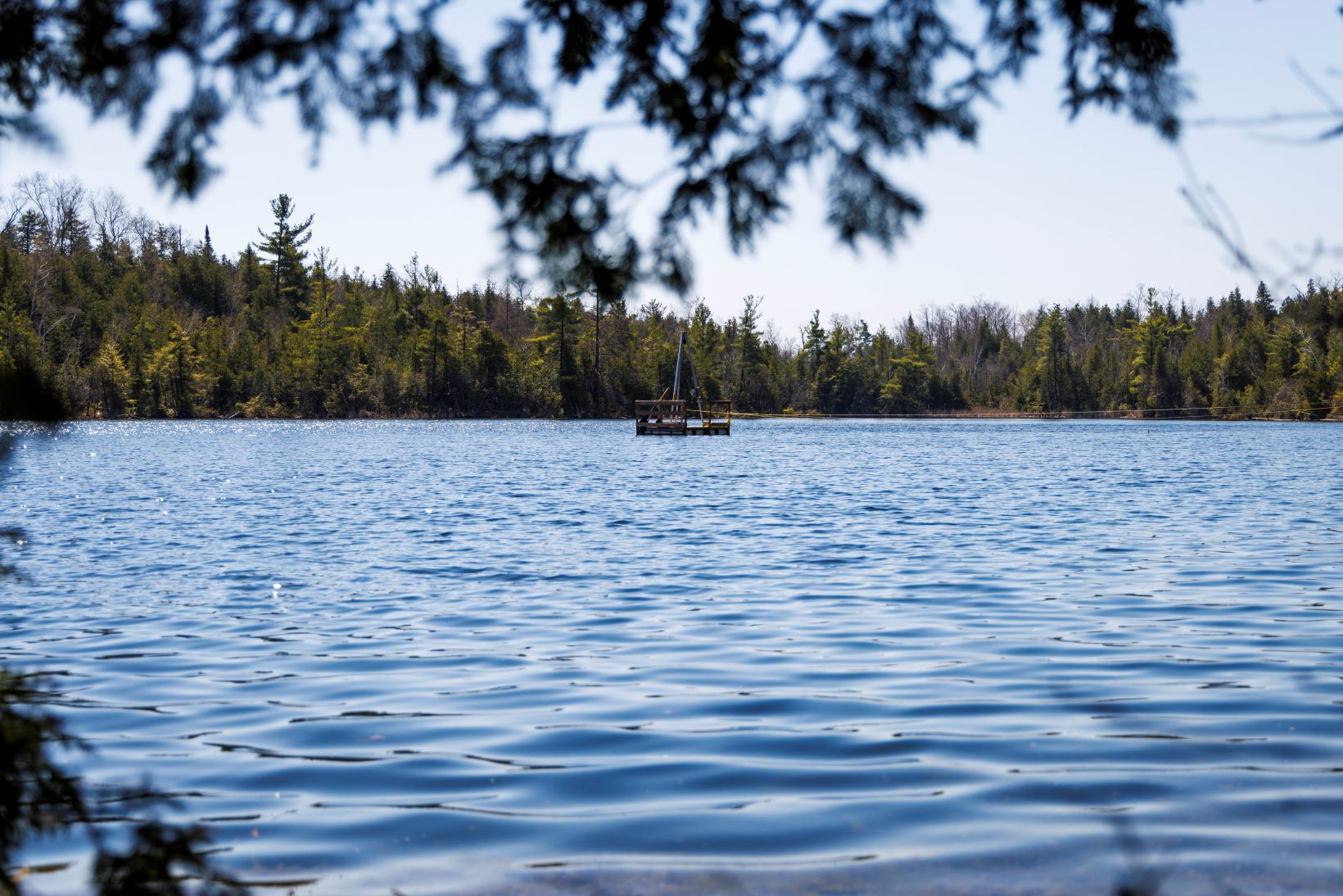For decades, scientific researchers from Canadian and international institutions have taken a special interest in Crawford Lake. This small body of water formed over 10,000 years ago as a rare meromictic lake, which is a type of deep lake with two layers of water that never intermix. The physical qualities of this tiny lake and its strict management as a protected area have contributed to well-preserved annual sediment layers in the lakebed. Researchers from around the world have proposed that we look to these layers and the stories they reveal about human-caused planetary change to help determine a new geologic epoch: the Anthropocene.
In Julio 2023, Crawford Lake was selected as the most suitable global marker site, or ‘Golden Spike’, to define the start of this proposed new epoch. With its unique physical features, importance to Indigenous community members, and international scientific significance, Crawford Lake is truly one of the most remarkable lakes in the world.
Why is this research significant?
Scientists have learned a great deal about the history of the land through examining changes in pollen, water chemistry, and composition of the sediment in the deepest part of Crawford Lake. Their most recent findings are the focus of a proposal to define a new interval of geologic time, the Anthropocene Epoch, which would end the Holocene Epoch in which humans have lived for almost 12,000 years, since the last ice age.
The International Commission on Stratigraphy is the body responsible for determining whether the Anthropocene will officially be added to the geologic time scale. However, the research to identify the Golden Spike has helped to deepen our understanding of recent human impact on the planet. Official recognition of the Anthropocene would be a defining moment for humanity where we acknowledge our ability to significantly alter natural systems. Research into the Anthropocene creates opportunities for conversations about how we can change the path that began in the mid-twentieth century, to avoid climactic and biodiversity collapse.




Preguntas frecuentes
Crawford Lake is a rare meromictic lake. In meromictic lakes, the water in the lower half does not mix with the water in the upper half, which can be partially attributed to the lake’s shape. This combined with the lake’s unique chemistry, causes sediment to settle in alternating light and dark layers, called varves, in the deepest part of the lake. One light layer and one dark layer are added each year and can be counted backwards in time like tree rings. By examining these well-preserved varves, scientists have learned much about the history of the land, locally, regionally, and globally over the past 1000 years.
The bottom waters of meromictic lakes are usually anoxic (meaning that they contain no dissolved oxygen). Crawford Lake is unique in that the full water column is oxygenated, making it exceptionally rare among meromictic lakes.
Scientists have learned a great deal about the history of the land through examining the microscopic changes in pollen, water chemistry, and composition of the sediment in Crawford Lake. Hot and dry years are visible as wide, light-coloured layers of sediment as heat causes calcium carbonate flakes to form in the upper layers of the lake in the summer; these flakes then settle to the bottom, much the same way scale forms in a tea kettle.
The Anthropocene is a new epoch proposed to be added to the geologic time scale. Other units of geologic time include eons, eras, periods, and ages, such as the Jurassic Period and the Paleozoic Era. The proposed Anthropocene Epoch describes the most recent years in Earth’s history when human activity has become the dominant force changing our natural systems (e.g., the climate). In 2019, research began to pinpoint the marker for the start of the Anthropocene in the sediment of Crawford Lake. If approved by the International Commission on Stratigraphy (ICS), this new unit of time will be formally named and added to the geologic time scale as our official latest epoch.
The starting date of the Anthropocene has been a matter of significant debate among scientists and researchers since the term was first used by atmospheric chemist Paul Crutzen in 2000. Current understanding has the Anthropocene beginning with ‘The Great Acceleration’ in the early 1950s. The Great Acceleration is the rapid and unprecedented growth of population, greenhouse gas emissions, and natural disturbance caused by humans that began after World War II, and which continues to this day.
To add the Anthropocene to the geologic time scale, evidence of a global change greater than what is to be expected in earth systems must be demonstrated in sediments found around the world. The marker that has been selected for the Anthropocene is the ‘bomb spike’ in plutonium from nuclear weapons testing that took place in the Pacific Ocean in the 1950s and 1960s. This marker corresponds with the start of The Great Acceleration and can be found in sediments, ice records, and coral growth rings around the world. The bomb spike is evident in the sediment of Crawford Lake even though the bomb testing took place over 9300 km away from the park.
The Golden Spike, known in geologic terms as the Global Boundary Stratotype Section and Point (GSSP), is the location that best demonstrates the sedimentary marker for a period of geologic time in sediment. It is known as the Golden Spike due to the installation of a bronze marker at the site once the unit of time is officially added to the geologic time scale.
Other locations around the world were examined in the search for the Golden Spike for the Anthropocene, including the Great Barrier Reef and the Antarctic Ice Sheet. Crawford Lake was selected as the proposed Golden Spike due to its remarkable sediment record which clearly demonstrates how humans have impacted the land over the past 1000 years.
It was also selected because it is protected within a Conservation Area and maintained in pristine condition for the benefit of the local ecosystem, researchers, and the public. Conservation Halton has protected the lake with a surrounding boardwalk and by prohibiting swimming, fishing, and boating. This has resulted in a healthy body of water and related ecosystems that offer an ideal location to educate the public about the proposed Anthropocene.
Documenting the start of the Anthropocene within a healthy, protected ecosystem helps us all envision the healthier, greener future we could create for future generations if we commit ourselves to protecting the green spaces we have left.
A multi-institutional team has been leading this research at Crawford Lake. This team includes Principal Investigators, Brock University Professors of Earth Sciences Francine McCarthy and Martin Head, and Earth Sciences Professor Tim Patterson from Carleton University. ‘Team Crawford’ also includes Queen’s University, the Royal Ontario Museum, the Canadian Museum of Nature, and researchers from other Canadian and international institutions.
Más información
There is a wealth of information available about the Anthropocene online, but here are a few links to get you started:
“Anthropocene Curriculum” (The Anthropocene Working Group)
https://www.anthropocene-curriculum.org/the-geological-anthropocene/site/crawford-lake
“Conserving sensitive environments can yield clues about Earth’s history, says Brock prof” (Brock University)
https://brocku.ca/brock-news/2023/01/conserving-sensitive-environments-can-yield-clues-about-earths-history-says-brock-prof/
“The Dawn of the Anthropocene” (The Royal Ontario Museum)
https://www.rom.on.ca/en/collections-research/magazine/the-dawn-of-the-anthropocene
“Are We Living in a New Geological Era? Carleton Research at Crawford Lake could help Pinpoint the Start of the Anthropocene” (Carleton University)
https://newsroom.carleton.ca/story/crawford-lake-research-anthropocene-era/
“A tiny lake offers a big story about the Anthropocene” (Canadian Museum of Nature)
https://www.youtube.com/watch?v=cq2c4fAmdCw
“Are we living in the Anthropocene? This Ontario lake could help global geologists decide” (The Narwhal)
https://thenarwhal.ca/anthropocene-ontario-lake/
“Humans vs The Earth: The quest to define the Anthropocene” (Nature)
https://www.nature.com/articles/d41586-019-02381-2
“Anthropocene” (National Geographic)
https://education.nationalgeographic.org/resource/anthropocene/
“Hidden beneath the surface” (The Washington Post)
https://www.washingtonpost.com/climate-environment/interactive/2023/anthropocene-geologic-time-crawford-lake/
“Scientists Choose Crawford Lake to Represent Start of Anthropocene Epoch” (The New York Times) https://www.nytimes.com/2023/07/11/climate/anthropocene-epoch-crawford-lake.html
“The Canadian Lake that marks the Anthropocene, when humans started changing the planet” (The Globe and Mail) https://www.theglobeandmail.com/canada/article-anthropocene-crawford-lake/
“Canada’s Crawford Lake chosen as ‘golden spike’ to mark proposed new epoch” (CBC news) https://www.cbc.ca/news/science/crawford-lake-anthropocene-1.6902999
“The Anthropocene is here — and tiny Crawford Lake has been chosen as the global ground zero” (Canadian Geographic)
https://canadiangeographic.ca/articles/the-anthropocene-is-here-and-tiny-crawford-lake-has-been-chosen-as-the-global-ground-zero/
“Why this Ontario lake has been chosen to help mark a planetary milestone” (Toronto Star)
https://www.thestar.com/news/canada/2023/07/11/why-this-ontario-lake-has-been-chosen-to-help-mark-a-planetary-milestone.html
“This small lake in Canada could hold markers of the next geological era. Here’s what’s at the bottom” (CTV News) https://www.ctvnews.ca/climate-and-environment/this-small-lake-in-canada-could-hold-markers-of-the-next-geological-era-here-s-what-s-at-the-bottom-1.6491486
“The Anthropocene: Canadian lake mud ‘symbolic of human changes to Earth’” (BBC) https://www.bbc.com/news/science-environment-66132769
“Crawford Lake: What the past can teach us about urban living today” (The Conversation) https://theconversation.com/crawford-lake-what-the-past-can-teach-us-about-urban-living-today-209764
“The Human Era Has an Official Start. It’s a Lake in Canada” (SciShow) https://youtu.be/25gBAa7CzIc?si=ZWk5IWrEDH1pIeWS
“Layers of meaning: Francine McCarthy on the Anthropocene” (Canadian Geographic) https://canadiangeographic.ca/articles/layers-of-meaning-francine-mccarthy-on-the-anthropocene/